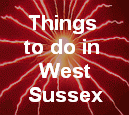
Famous writers with West Sussex connections
Poets, writers and novelists
Any look at West Sussex writers has to start with Hilaire Belloc, not because he was the best writer associated with the county, but because he wrote more about Sussex than any other significant writer. Despite being born in France, Belloc spent much of his childhood in Slindon and famously bought Kingsland, with its wonderful windmill, in the village of Shipley in his later years.Mystic poet and artist William Blake lived in Felpham and was tried for sedition in Chichester for the trivial offence of knocking the hat off an obnoxious soldier while being a bit of a leftie. Happily common sense prevailed and he was found not-guilty. It is said that his lyrics to Jerusalem were inspired by the view towards the Downs from Lavant.
Blake illustrated the work of his Felpham co-resident William Hayley. Hayley was born in Chichester in 1745. Although he is best known for his biography of his friend William Cowper, he was an accomplished enough as a poet to be offered the post of Poet Laureate in 1790. He declined and the rest, as they say, isn't history.
Important 17th century poet William Collins started and ended his life in Chichester. By all accounts he had a rather miserable time and the true value of his writing was only appreciated fully after his death.
Alfred, Lord Tennyson, one of the greatest poets of the English Language, lived in an inspirational place in Sussex – on top of Blackdown, the highest place in West Sussex. Tennyson lived at Aldworth - the house he built in 1869 to help him get away from it all.
17th century playwright Thomas Otway was bown in Trotton near Midhurst in 1652 and was brought up in neighbouring Woolbeding. His two masterpieces are The Orphan and Venice Preserved.
Great romantic poet Percy Bysshe Shelley grew up at Warnham near Horsham and his erratic life and work are celebrated in Horsham Musuem.
HG Wells was brought up at Uppark, where his mother was on the payroll and he went to school and taught in Midhurst for while. Wells soon moved to London, but remembered West Sussex in his work. The story of The Invisible Man starts in the Rother Valley village of Iping when a stranger walks into The Coach and Horses swathed in bandages and excessive clothing – the Invisible Man in person. Mysterious events follow and the village is soon buzzing with intrigue.
20th and 21st century writers in West Sussex
The writer of the Gormenghast series of books, Mervyn Peake, lived, wrote and painted at School House in Warningcamp near Arundel from 1940 to 1946. He is buried in the churchyard at St Mary the Virgin, Burpham.John Galsworthy, playwright and author of the Forsyte Saga bought a large house in Bury in 1926 and lived there until his death seven years later. Rather stylishly, his ashes were scattered over the South Downs by an aircraft.
Popular childrens’ writer Rosemary Sutcliff lived in the village of Walberton near Fontwell for many years. Sutcliff was the author of many works of historical fiction, especially set in Roman Britain and the Dark Ages.
Ted Walker was born in Lancing, went to school in Steyning, married in Shoreham and taught in Bognor and Chichester. Walker is best known for his poetry and Fox on a Barn Door contains his impressions of the Sussex countryside.
Irish novelist and trades unionist campaigner Brian Behan moved to Shoreham in 1964 after an arm injury ended his career as a bricklayer. Taking up a writing course at the University of Sussex, this proved the catalyst for a successful career as a writer and self-publicist.
Crime writer Peter Lovesey lives near Chichester.
Modern poet and novelist Maureen Duffy was born in Worthing.
Bestselling author Kate Mosse, the author of Labyrinth and Sepulchre went to school in Chichester, worked at Chichester Festival Theatre for a while and still lives near the city.
Writers with connections to West Sussex
Welsh Super-Tramp poet WH Davies got married in East Grinstead and lived in the town for a few years in the 1920s.Sci-fi and fantasy writer Neil Gaiman, best known for his Sandman series, lived for many years in East Grinstead before settling in the USA.
As commemorated by a plaque high above Eastgate Square, John Keats started to write the Eve of St Agnes in Chichester in 1819.
Playwright Christopher Fry lived in East Dean near Chichester in his later years.
The great chronicler of the English and Sussex countryside Richard Jeffries died of tuberculosis in Worthing in 1887 having moved to the seaside to improve his ailing health.
Thriller writer Hammond Innes was born Horsham.
Emily Alice Haigh a.k.a. poet Beatrice Hastings committed suicide in Worthing in 1943.
William Henry Hudson, who was not only a successful and prolific author, but also a well-regarded writer on ornithology is buried in Worthing where he passed his final years.
Lord Alfred Douglas, author, poet, lover of Oscar Wilde and all round tragic figure died in Lancing and was buried in Crawley in 1945.
- Roman Sussex
- Saxon Sussex
- The sea and its effect on coastal communities over the centuries
- Key dates in the history of West Sussex
- Bands
- Choral music
- Classical music
- Classical recitals
- Folk
- Gigs
- Gospel
- Jazz and swing
- Operatic music
- Orchestral music
- Singers
- Music festivals
- Music promoters
- Other festivals
- Sussex music guide
- Live music venues
- Listings

